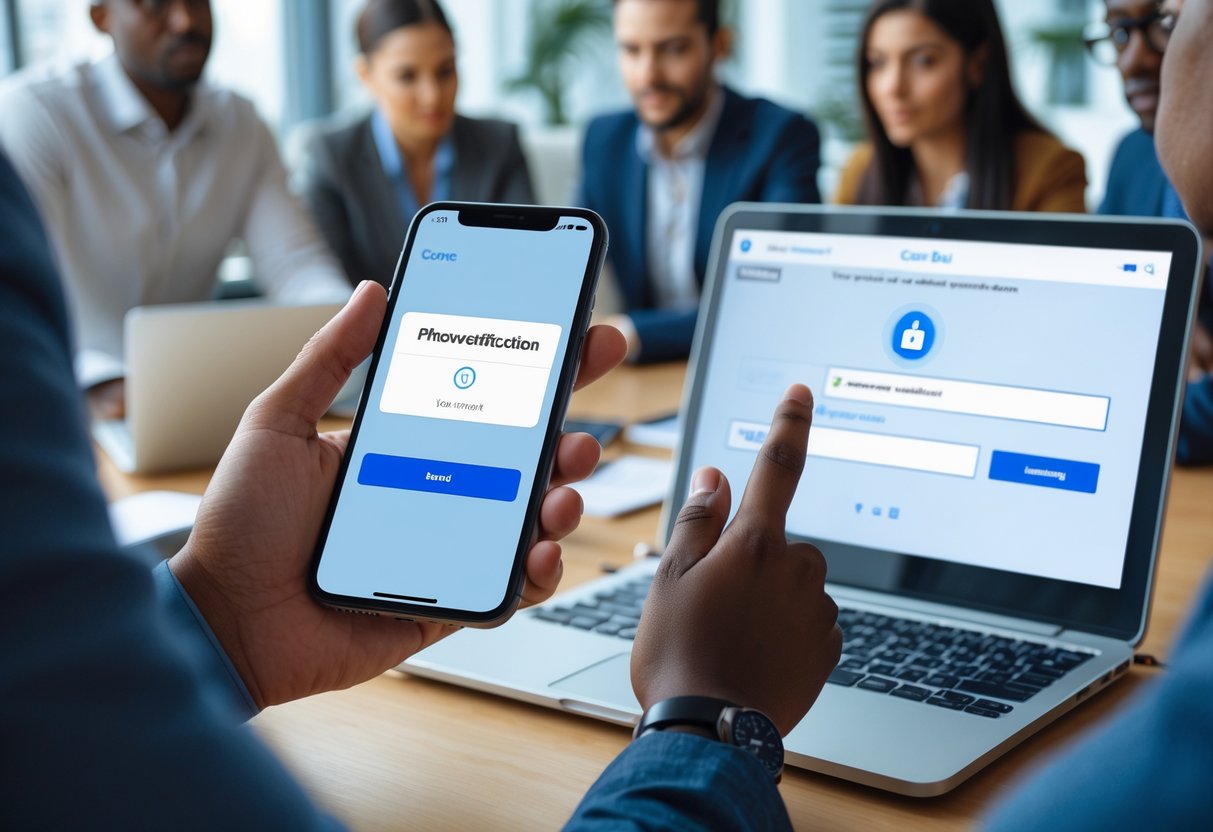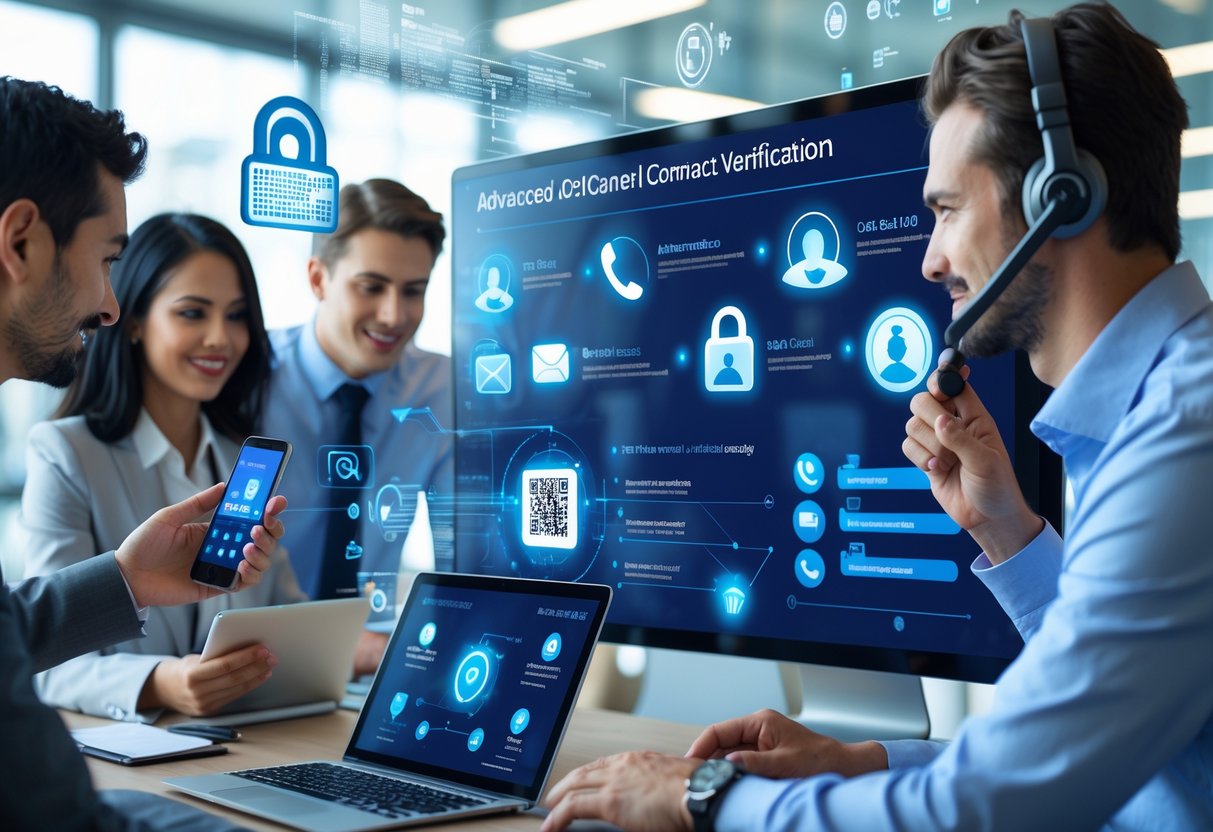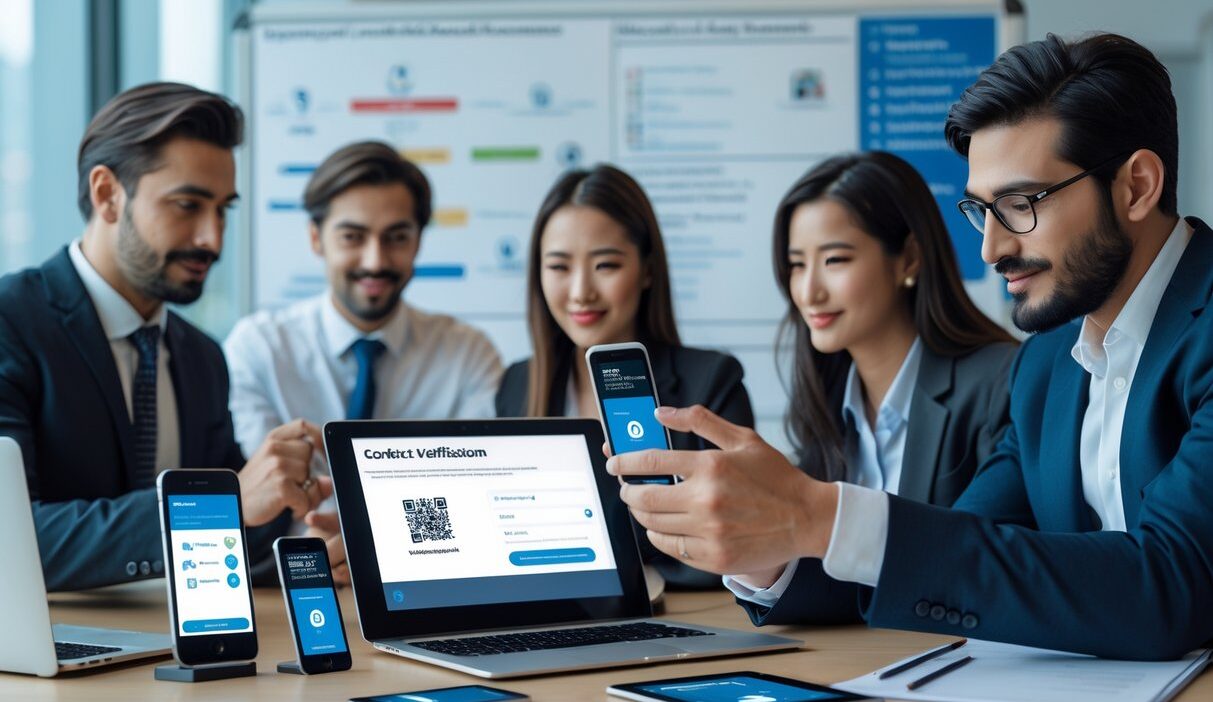Ever wonder if the person you’re talking to online is actually who they say they are? Contact verification is how you check if an email, phone number, or even an identity truly belongs to that user.
Contact verification is basically double-checking that contact details are real, up-to-date, and secure.

I put a lot of emphasis on these methods because they keep people safe from fraud and help conversations actually reach the right folks. Whether it’s a one-time code sent to a phone, a link in your inbox, or something fancier like voice recognition, each has its ups and downs.
If you understand how these work, you can pick the best mix of security and convenience. Honestly, why waste time fighting with unreliable leads or risky contacts?
Key Takeaways
- Contact verification makes sure info is accurate and trustworthy.
- Different methods give you different levels of security and ease.
- Picking the right method boosts both safety and the whole user experience.
Fundamentals of Contact Verification
I use contact verification to check if details like phone numbers, emails, or addresses are actually real and belong to the person claiming them. That way, mistakes drop, trust goes up, and fraud gets shut down before it even starts.
What Is Contact Verification?
When I talk about contact verification, I mean making sure details are correct, current, and really tied to the right person. This covers phone numbers, emails, and even physical addresses.
Sometimes, it even means checking identity info linked to those contacts. For emails, you’ll usually see a code or link sent for confirmation.
Phone numbers get SMS codes or calls. Addresses might get checked with postal databases or third-party services.
Accuracy is the big goal here. If a company sends stuff to the wrong place, you lose trust and the message never lands.
By verifying from the start, I make sure customers get their updates, bills, and alerts.
Why Contact Verification Matters
Contact verification is seriously crucial for security and just basic communication. If you skip it, you risk sending private info to the wrong person, which could mean fraud or leaks.
On top of that, strong verification helps meet industry rules about personal data. From a customer’s side, verified contacts mean no missed messages and less hassle.
A verified phone number, for example, lets someone reset a password instantly. A verified email means purchase confirmations and support updates show up when needed.
Companies also save money by not sending stuff to dead ends. Marketing gets sharper, support gets easier, and everyone feels safer.
Verification Process Overview
I break the verification process into steps that keep things accurate but don’t annoy people. Usually, this starts when a customer gives their info during sign-up or checkout.
Some common methods I use:
- One-time passwords (OTPs): Quick codes sent by text or email.
- Email confirmation links: Click to prove it’s yours.
- Database checks: Match info with trusted sources.
- Knowledge-based checks: Security questions only you should know.
Each method fits a different need. OTPs and links are fast and user-friendly. Database checks are great for addresses and phone numbers.
I always try to balance speed with accuracy. Automation helps, but I make sure people know why we’re verifying—it’s for their own safety.
If you want your verification handled right or just want to buy quality leads instead of struggling, feel free to contact me on WhatsApp at +917303556188. Honestly, why do it the hard way?
Email Verification Techniques
I use email verification to make sure addresses are valid, active, and can actually get mail. The steps I take target typos, fake signups, or dead inboxes.
Syntax and Domain Validation
First, I check the format. Does the email have an “@” and a real domain ending? If it’s missing something or looks weird, I toss it.
Next, I check if the domain exists and is set up for email. For example, “example@domain.com” needs a real domain with working mail records.
This is quick and cheap, but it doesn’t confirm if the mailbox is real. So I always follow up with deeper checks.
Mailbox Existence Checks
After the basics, I see if the mailbox actually exists. I use SMTP checks, which kind of “ping” the server to see if it’ll accept mail for that address.
Not all servers let you do this, so results aren’t perfect. That’s why I mix in other checks too.
Mailbox verification helps avoid bounced emails and keeps my sender reputation clean. Sending to dead addresses gets you flagged as spam, so this step is non-negotiable.
Deliverability Assessment
Even if a mailbox is real, messages might still not land. I look at things like disposable email services or generic addresses like “info@domain.com.”
These usually have low engagement and higher risk. I also check for authentication standards like SPF, DKIM, and DMARC.
Some tools score emails based on risk. I use those to decide if I should keep or drop an address. If you’re tired of fighting with bounces and spam issues, why not just get leads that are already verified?
Reach out on WhatsApp at +917303556188 if you want to skip the hassle.
Phone Verification Approaches

I use phone verification to make sure a number is real, reachable, and belongs to the right person. This means checking the number’s structure, sending a code, or even confirming with the phone carrier.
Format and Line Type Validation
First, I check if the number looks right. Country code, length, and the basic structure all have to match up.
I also figure out the line type: is it mobile, landline, VoIP, or toll-free? SMS only works with mobile, but landlines need calls.
Some tools automate these checks, saving time and cutting out dead numbers before you even start. This step is a must before going any further.
Automated and Manual Calling
I use both automated and manual methods. Automated calls or texts send a quick code for users to enter.
Manual calling is for the rare cases where automation won’t work. Sometimes you just have to call and talk to a real person.
Platforms like Twilio and Nexmo make it easy to send codes to tons of numbers. I trust these tools when I need to verify a lot of contacts fast.
Carrier and Connection Checks
I dig deeper by checking with the carrier. Is the number active, in service, and on the right network? Is it temporary or disposable?
Carrier checks can show roaming status, if the number was recently ported, and if it’s prepaid or postpaid. All these details help me figure out if I can trust the number.
Services that offer real-time carrier lookups flag risky numbers before you finish a transaction. This way, I cut down on mistakes and boost trust.
If you’re tired of chasing down dead numbers, just let me handle it. Message me on WhatsApp at +917303556188 and get quality leads without the headache.
Advanced and Multi-Channel Verification Methods

Sometimes you need more than just a password or code. I use advanced methods that pull in extra data, behavior signals, and outside references.
These steps make it way harder for fraudsters to sneak in, and they keep things smooth for legit users.
Cross-Reference Validation
I cross-check info from different sources. For example, I’ll see if a phone number matches what’s in a customer’s account, then compare it to billing details.
Fraudsters usually can’t fake info across multiple systems. If something doesn’t line up, I get suspicious.
I mix customer records, telecom data, and payment info for a strong defense. Even if one piece gets compromised, mismatched data elsewhere helps me catch problems.
Social Profile Matching
I check if the details people give me match up with their public profiles. If a phone number or email shows up on LinkedIn or Facebook with the same name, that’s a good sign.
I look at how old the profile is, how many real connections it has, and how active it seems. Real accounts have history; fakes usually look empty.
Social matching isn’t bulletproof, but it’s a solid extra check when combined with other methods.
Recency and Activity Monitoring
I keep an eye on how recently and how often a number or account gets used. If a number’s been dead for months and suddenly pops up for a big purchase, that’s a red flag.
I track last login, transaction dates, and how steady the activity is. When I spot weird patterns, I can pause things before fraud happens.
If you want leads that have already passed these checks, just ping me on WhatsApp at +917303556188. Why risk your business on sketchy data?
Security and Compliance in Contact Verification

When I secure contact verification, I focus on keeping out the wrong people, locking down data, and following privacy laws. Each piece matters, and together they keep everyone safe.
Preventing Unauthorized Access
I stack up layers of authentication to keep out intruders. Multi-factor authentication (MFA) mixes passwords with codes sent to your phone.
I use biometrics like fingerprints or face scans when I can. These are way tougher to fake than a password.
In call centers, I lean on caller authentication using voice recognition or passkeys. It’s better than old-school security questions.
Single Sign-On (SSO) is another trick I use. One strong login for everything means fewer weak passwords floating around.
If you want your verification and leads handled with real security and less stress, just message me on WhatsApp at +917303556188. Seriously, why make it harder than it needs to be?
Mitigating Data Breaches
Data breaches? They’re a nightmare—just one can wreck trust in a flash. That’s why I always start by cutting down on how much sensitive data I keep. If I don’t need it, I don’t bother holding onto it.
When I do need to store info, I make sure to encrypt it—doesn’t matter if it’s moving or just sitting there. Even if someone breaks in, what are they gonna do with scrambled data?
I rely on monitoring tools that ping me if something fishy happens, like a bunch of failed logins or big downloads out of nowhere. Automation is a lifesaver here, too.
Human error? Yeah, it happens, but I use identity verification software with AI to catch fraud and mistakes before they cause problems. I’m also a fan of regular audits and penetration tests. Better I spot the holes than some hacker.
Honestly, if you’re tired of dealing with all this, just let me handle it. Why stress? Feel free to contact me on WhatsApp for leads or a quick consultation: +917303556188. I’ll make your life a lot easier.
Regulatory and Privacy Considerations
Dealing with personal info isn’t just about good intentions—there are strict rules. GDPR in Europe, HIPAA in the US—they all mean I have to collect data for a clear reason and keep it locked down.
If you mess up, it’s not just fines. People stop trusting you. That’s the real cost.
So, I keep records of how I collect, process, and store customer info. I also make sure people know why I’m asking for their data. Contact point verification is usually about emails, phone numbers, or addresses, so I’m upfront about how I’ll use their details.
Depending on the country, I tweak my process. Some places care more about age checks, others about financial info. I adjust so I’m always in line with local laws and don’t run into trouble.
Frankly, if you want to avoid the headache of compliance, just ping me on WhatsApp at +917303556188. Why do it the hard way? I’ve already figured it out.
Optimizing the Customer Experience
Nobody likes jumping through hoops. I get it—customers want fast access, but they don’t want to feel like security is slowing them down.
Balancing Security and Usability
My goal? Keep things secure, but don’t make people jump through a dozen steps. Too many checks, and folks give up. Too few, and you open the door to fraud.
So, I layer methods. Maybe I use knowledge-based authentication for identity, but I’ll throw in voice biometrics as backup. It’s about not relying on just one thing.
Riskier actions get more checks. If someone’s just checking their balance, a PIN might do. But for transferring big money? I crank up the security.
I also try to explain why I’m asking for info. If people get the point, they’re less annoyed by the process.
Honestly, if you want this kind of setup without the hassle, just message me on WhatsApp: +917303556188. Let me do the heavy lifting.
Streamlining Verification Steps
Long, repetitive steps? No thanks. I keep things short and sweet, but still accurate.
For example, I use automatic number identification (ANI) to spot a caller’s number and match it to their account. It’s not perfect, but it speeds things up and saves everyone time.
Clear instructions help, too. If people know what to do, they mess up less and get through faster. I always offer backup options—if ANI fails, I switch to knowledge-based questions.
Honestly, if you want a smooth, secure process without reinventing the wheel, just reach out to me on WhatsApp: +917303556188. Why struggle when you could just buy leads or get advice from someone who’s already done it?
Frequently Asked Questions
People ask me all the time about confirming contacts, using security features like Contact Key Verification, and what methods big platforms use. These are the basics you actually deal with in real life.
What steps are involved in verifying a contact on an iPhone?
I open the Contacts app, pick the person, and check if their number and email match what they gave me. If I’m not sure, I’ll send a quick message or call to double-check.
How does Contact Key Verification work in iMessage?
With Contact Key Verification, Apple gives me a code to compare with my contact. If we both see the same thing, I know nobody’s messing with our messages.
What are the standard methods for verifying a phone number online?
Usually, you’ll see SMS codes, voice calls, or email links. Sometimes there are authenticator apps or push notifications. It’s just about proving you control the number before you get in.
How can users disable Contact Key Verification if needed?
You can turn it off in iPhone settings under Apple ID and iCloud. Once it’s off, you skip the extra step, but you lose a bit of security.
What are the implications of having Contact Key Verification enabled or disabled?
If you keep it on, you’re safer from impersonation and tampering. Turn it off, and things get easier, but you lose that security net. It’s really about what matters more to you: convenience or safety.
If you’ve read this far and you’re thinking, “Why am I doing all this myself?”—just hit me up on WhatsApp at +917303556188. Whether you need leads or advice, I’ll save you time and headaches. Why not let someone else do the hard work?
What are the common types of verification used by Microsoft for phone calls?
So, Microsoft usually goes with automated voice calls, SMS one-time passcodes, or sometimes those push notifications on the Microsoft Authenticator app. Basically, they’re just double-checking it’s really you before letting you reset a password or poke around your account.
Honestly, if you need help with this stuff or just want to skip the headache and buy verified leads, feel free to contact me on WhatsApp at +917303556188. Why struggle alone when you can make it easy?



